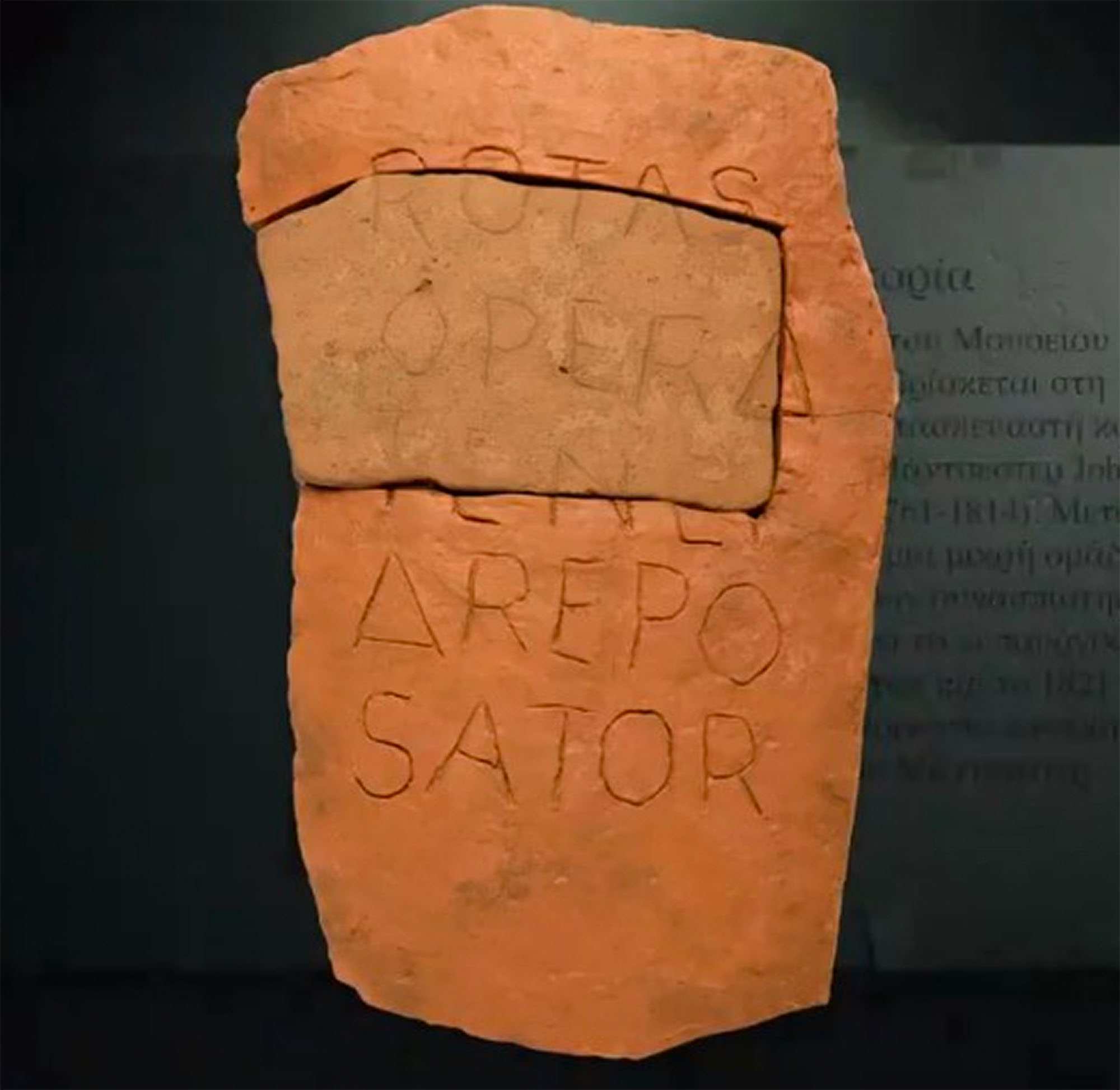
in English original
This object has been translated into 6 different languages by 6 different users
One of the most iconic objects in our Archaeology collection, this piece of broken pottery was found in an excavation in Manchester city centre in 1978.
It dates from 180 AD. Back then, Manchester was a Roman settlement called Mamucium, consisting of a fort – where soldiers lived and military life was organised – and a civil area that developed outside the fort called vicus. Foreign troops serving in the Roman army came to attend the Mamucium fort. They came from the provinces of Germania, Galia, Hispania… the multicultural Manchester that we know and love has been that way for a long time!
This fascinating Latin inscription may be the earliest evidence of Christianity in northern Britain. It reads ROTAS OPERA TENET AREPO SATOR or ‘Arepo the sower guides the plough with care.’
The words read the same in all directions. Re-arranged the letters spell out Pater Noster or ‘Our Father’, crossing at the N. This omits letters A and O. In the Bible, Jesus said: “I am Alpha and Omega, the beginning and the end.”
The Manchester Wordsquare might have been used as a secret symbol, demonstrating belief in Christianity at a time when the Christian Church was being oppressed by the Roman authorities. Others think it was simply a word puzzle or pastime.
What do you think?
Do you have something you’d like to say, in your own language or English, about the object or translation? We’d like to hear what you think.
Translations are community-sourced and for anyone to participate in, however you use your language. For more information, see Community Guidelines.
17 Nov, 2023
曼城文字魔方阵, very good, thank you
11 Apr, 2023
The first known version of this square is in Pompeii, and there is a Facebook image from the Pompeii museum with a caption about it:
“It is in Pompei that this magic square, a famous Latin cryptogram that would be copied many times in the following centuries, first appears, in a room of the Casa di Paquio Proculo (House of Paquio Proculo) and on a column in the Palestra Grande (Large Gymnasium). Many theories have been put forward regarding its meaning. The square is made up of five words of five letters each (sator, arepo, tenet, opera, rotas), written one under the other in such a way that it forms a square that can be read in any direction, forming a palindrome. The 25 letters themselves, rearranged, can form the words “Pater noster” (our father, from the Catholic prayer) twice [with two extra a’s and two extra o’s, which supposedly can represent the “alpha” and “omega”, which are important in Catholic symbolism (see Wikipedia on this: https://en.wikipedia.org/wiki/Sator_Square#Paternoster_theory. It’s really hard to picture without seeing it)]. If you read the square following a zig-zag [you have to repeat the middle row in both directions], you can read “sator opera tenet – tenet opera sator”, that is, “the sower possesses [his] works” (repeated in another order because Latin doesn’t depend on the order of words as much as English does), perhaps talking about a Christian God who created the world. And finally, the word “tenet”, which crosses itself at the centre of the square can be seen to represent a hidden version of the Christian cross used by the early Christians, who might not have been able to be open about their religion, as this example comes from 79 C.E., less than 50 years after the death of Christ in the Christian religion, and a period when Christians were still persecuted for their beliefs. This hypothesis is fascinating, but the symbol of the cross wasn’t really used until much later in history, so perhaps the magic square is just a bit of wordplay that was later reinterpreted to have a Christian message…”
11 Apr, 2023
The Italian source for the text above, and a link where you can see the image:
https://www.facebook.com/pompeiisoprintendenza/photos/il-quadrato-magico-di-pompei-ovvero-il-famoso-crittogramma-in-latino-pi%C3%B9-volte-r/1597578133882732/
Il quadrato magico di Pompei, ovvero il famoso crittogramma in latino più volte riprodotto nei secoli a venire, appare per la prima volta proprio a Pompei, graffito in una stanza della Casa di Paquio Proculo e su una colonna della Palestra Grande. Sul suo significato sono state costruite molte teorie. Si tratta di cinque parole di cinque lettere ciascuna (sator arepo tenet opera rotas), scritte di seguito una sotto l’altra in modo da formare un quadrato, che possono essere lette in qualsiasi direzione formando un palindromo. Le 25 lettere, scomposte e ricomposte, formano due volte l’espressione Pater Noster. Se si legge il quadrato a serpentina, inoltre, si ha “sator opera tenet – tenet opera sator”, cioè “il seminatore possiede le opere”, ovvero è il signore del creato. E ancora, l’incrocio delle due parole tenet disegna al centro del quadrato una croce perfetta: si tratterebbe di una raffigurazione cifrata dei primi cristiani, considerando che siamo prima del 79 d.C., siamo a meno di 50 anni dalla morte di Cristo! L’ ipotesi e’ affascinante, ma considerando che il simbolo della croce e’ molto piu’ tardo, il quadrato magico e’ solo un calembour reinterpretato successivamente come messaggio cristiano….
31 Mar, 2023
Me gusta la traducción al español!
31 Mar, 2023
Muchas gracias, Yaron